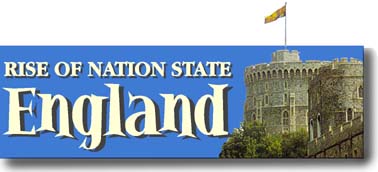|
|


Mr. Sedivy's
History Classes:









More Features:


 

 

|
|
Highlands Ranch High School - Mr. Sedivy
Highlands Ranch, Colorado
Rise of Nation State England
- Dark Ages Leaders of England
-
Alfred the Great, Edward the Elder, Athelstan
Alfred the Great (871 - 899)
Alfred is remembered as England's schoolmaster. Alfred the Great is
also remembered as the king who saved England from the Danes. He defeated
them in battle, built strongholds or "burhs" for defense, and reformed
the army of Wessex. Alfred was determined to improve learning and education
in his kingdom. He invited scholars from home and abroad to his court.
He had no schooling in his youth. Like most Anglo-Saxon kings, he was
brought up to be a soldier and to love hunting.

Silver penny of King Alfred "The Great"
Up to Alfred's time, English was mainly a spoken language. Songs,
stories, and poems were learned and recited, but few seem to have
been written down. The laws of kings had to be written in English,
because they were for all the people, not just the educated. He wanted
to translate important books into English. Then the sons of his thanes,
who one day would help to govern the kingdom, could be taught to read
in "the language we can all understand."
Edward the Elder (899 - 924)
Alfred's kingdom passed to his son, Edward, the Elder. Edward the
Elder is remembered for his re-conquest of the Danelaw. His main aim
was to conquer the Danelaw. The Mercians, who no longer had a king
of their own, fought on Edward's side. They were led by his sister
Ethelfleda (a.k.a. First Lady of the Mercians). The English made a
two-pronged advance in to the Danelaw - Edward from the south, and
Ethelfleda from the west.

Silver penny of King Edward the Elder, king of the
West Saxons
 In each newly-won area, a burh was constructed.
In each newly-won area, a burh was constructed.
 The Danes offered little serious resistance.
The Danes offered little serious resistance.
 Many were settled down and were prepared to accept Edward as their
king, provided that they could go on farming in peace.
Many were settled down and were prepared to accept Edward as their
king, provided that they could go on farming in peace.
 This suited Edward. In 920, the conquest of the Danelaw was almost
complete.
This suited Edward. In 920, the conquest of the Danelaw was almost
complete.
 At the end of Edward's reign, all of the English in the South and
Midlands looked to him as their king.
At the end of Edward's reign, all of the English in the South and
Midlands looked to him as their king.
Athelstan (924 - 939)
Edward's son, Athelstan, carried on where his father had left off.
Athelstan now called himself "Rex Totius Brittannae" (King of all
Britain) on his coins. The kingdom of England, therefore, grew out
of the kingdom of Wessex.

Silver penny of King Athelstan. The king is shown beardless,
in the Roman tradition.
Shires, Hundreds and Towns
Once the Danelaw had been conquered, it was divided in to "Shires,"
many of them centered round towns, such as Derby, Nottingham, and
Leicester. Nowadays, we call these local divisions "counties."
Each shire had its law court or shire moot. They met for serious
crimes and disputes. In return for their service to the king, "ealdormen"
were given money and large estates. Some became very powerful nobles,
controlling several shires at once. Duties in each shire were given
over to a "shire-reeve," or sheriff.
London had long been the main center of shipping and overseas trade.
One thing that would strike us about Anglo-Saxon towns would be the
large number of churches. By the eleventh century, there were about
twenty in Norwich - roughly one for every 300 people. Experts can
only give a rough estimate of the size of these towns:
 London population approx. 10,000.
London population approx. 10,000.
 York and Winchester over 8,000 citizens.
York and Winchester over 8,000 citizens.
Back to top of page
Mr. Sedivy's Lecture Notes
& Historical Info
The Celts
| Gallic He-Men | Celtic
Culture, Trade, Religion, Women |
| Threat of the Celts - Celtic Battles and
Conquests |
- Rise of Nation State England -
| Roman Conquest of Britain | Christianity
in Britain |
| Customs: Thanes, Churls, Thralls, Wergeld,
Folk-Moot |
| Dark Ages: Alfred the Great, Edward the
Elder, Athelstan |
| The Return of the Vikings |
| Kings of Britain: Aethelred, Cnut, Edward
the Confessor |
| Bayeaux Tapestry, William the Conqueror,
Edward the Confessor, Harold Godwinson, Harold II |
| The Crusades: Richard Lion Heart, Pope
Urban |
| King John, Innocent III, Archbishop Stephen
Langton |
| Magna Carta / First Parliament |
Wales and Scotland
| Wales: Edward I, Llewellyn, Snowdonia
|
| Scotland: Alexander III, John Balliol,
William Wallace, Robert Bruce, King Edward II |
The 100 Years War
| Edward III, Longbows at Crecy, Edward IV,
Black Prince |
| Henry V, King Charles VI, Battle at Calais,
Treaty of Troyes |
More Information
| Other Kings of the Dark and Middle Ages:
William II, Henry I, Henry II |
| The
British Monarchy's Peerage: Dukes, Viscounts,
Marquess, Earls, Baronets, and Barons |
Class Activities
Roman Conquest Comparison
Battle of Agincourt
Related Information
Mr. Sedivy's World History - The Middle
Ages
The Complete Bayeux Tapestry
Roman Catholic Church in the Middle Ages
/ Crusades
The Hundred Years War
King Henry VIII
The Interesting
Life of Elizabeth I
The Stuarts - James I, Charles I, Charles
II, James II
Oliver Cromwell
|
|
|



![]() 9375 South Cresthill Lane
9375 South Cresthill Lane ![]() Highlands Ranch, Colorado 80126
Highlands Ranch, Colorado 80126 ![]() 303-471-7000
303-471-7000



